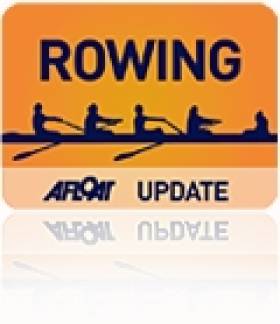Displaying items by tag: Pres, Cork
Shandon/Presentation Eight Fastest at Cork Head
#ROWING: A composite men’s senior eight of Shandon Rowing Club and Presentation Brothers College, Cork were the fastest crew at the Cork Head of the River today. They outpaced two other senior eights: a Shandon/Cahir composite and Cork Boat Club. The UCC intermediate eight were the second fastest overall, clocking 12 minutes 36.6 seconds - just under seven seconds off the winning time. John Keohane of Lee Valley was the fastest single sculler on the day, and Amy Bulman recorded the fastest time for a woman.
Cork Head of the River (Selected Results)
Men
Head One:
Eight – Senior: 1 Shandon/Presentation 12 minutes 29.7 seconds, 2 Cork BC 12:44.8, 3 Shandon/Cahir 13:29.7. Intermediate: UCC 12:36.6. Junior 18: Cork 12:55.7.
Head Two:
Sculling, Single – Senior: Lee Valley (J Keohane) 15:10.7. Inter: Lee (D O’Sullivan) 15:44.7. Jun 18: 1 Fermoy (G Morrison) 15:53.8, 2 Athlunkard (E Gallagher) 16:09, 3 Lee (H Deasy) 16:09.5. Jun 16: Lee (L Guerin) 16:35.3.
Head Three:
Four – Senior: UCC 13:58.8. Inter, coxed: Cork 14:19.4. Jun 18, coxed: Muckross 17:21.9. Jun 16, coxed: Fermoy 16.44.2.
Head Four:
Sculling, Quadruple – Inter: Shandon 14:08.7. Club Two, coxed: Clonmel 15:46.5. Jun 18: Cork 14:16. Jun 16, coxed: Cork 14:47.5.
Head Five:
Pair – Jun 18A: Cork 16:36.0.
Head Six:
Sculling, Double – Inter: Presentation, Cork 15:41.6. Club Two: Shandon 16:52.7. Novice: St Brendan’s 19:15.3. Jun 18A: Shandon 15:41.4. Jun 16: Lee 16:43.0.
Rolling Head
Eight – Intermediate: Muckross 14:22.3. Masters: Fermoy 14:16.6.
Pair – Jun 18A: Pres, Cork 17:39.9.
Sculling, Quadruple – Inter: UCC 15:59.5. Club Two, coxed: Fermoy 18:27.8. Novice, coxed: St Brendan’s 16:19.0. Jun 18A: Pres, Cork 14:32.0. Jun 16, coxed: Pres, Cork 14:36.2. Masters: Shandon 15:31.3.
Double – Jun 18: Presentation, Cork 16:05.4. Jun 16: Skibbereen 16:21.6.
Single – Senior: Clonmel (A Chadfield) 16:57.2. Jun 18: Skibbereen (K Mannix) 17:18.5. Jun 16: Skibbereen (D O’Sullivan) 18:47.5. Masters: Cahir (D Heffernan) 16:49.3.
Women
Head One:
Eight – Intermediate: UCC 15:24.3.
Sculling, Quadruple – Club Two, coxed: Lee 15:08.5. Novice, coxed: Fermoy 16:55.6. Junior 16, coxed: Cork 15:34.9.
Head Two:
Pair – Senior: Cork 16:38.2. Junior 18A: Lee 16:54.8.
Head Three:
Sculling, Double – Senior: UCC 15:45.0. Jun 18A: Cork 16:45.6. Jun 16: Lee 16:33.0.
Head Five:
Sculling, Single – Senior: 1 UCC (A Bulman) 17:57.3, 2 Cork (M O’Neill) 18:10.8. Inter: UCC 19:11.1. Novice: Lee 21:03.1. Junior 18A: Muckross 19.04.0. Jun 16: Lee Valley 19:17.8.
Rolling Head
Eight – Jun 16: Shandon 16:29.9.
Four – Masters, coxed: Clonmel 18:59.4.
Pair – Senior: UCC 17:33.3.
Sculling, Quadruple – Club Two, coxed: Fermoy 18:27.8. Jun 16, coxed: Shandon 15:57.8.
Double – Jun 18A: Clonmel 17:57.4. Jun 16: Fermoy 17:27.1.
Single – Senior: Fermoy (S Bouanane) 17:36.4. Inter: Fermoy (S Bouanane) 19:25.9. Jun 18A: Fermoy (S Cotter) 18:40.5. Jun 16: Shandon (C Minehane) 17:51.5.
























































